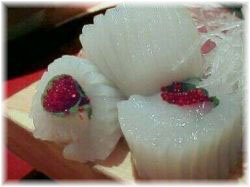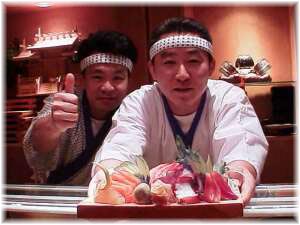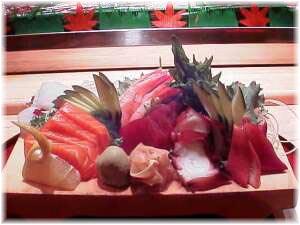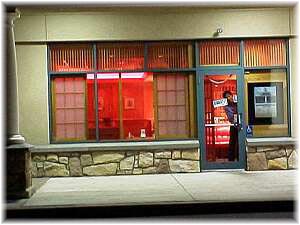one definition of Bob:
“All
unfresh sushi are alike; each fresh sushi is tasty in its own way. ”
—with apologies to Tolstoy
Japanese food. I've been eating it since the early 80's, when my boss came back from a business trip to Japan, and had eaten sushi and shabu-shabu. He insisted that I try it.
I was quite eager to try sushi, as it was just catching on as a chic food in the US, and I was... well, I was a Yuppie, and expensive food was a central part of my life.
When it arrived, I was taken by its presentation. It was like no food I'd ever seen before. Edible Art. However, I must admit that I was disappointed by the taste. I was expecting something strong and fishy, but as we know, fresh sushi doesn't taste fishy. Most sushi has very subtle flavors (which is why you shouldn't drown it in the soy sauce).
The Three "T"s of Sushi
 But still there
was something intriguing about the stuff. As I thought about it, I decided
there were three components that made up the experience of eating sushi, and
taste was only one of them. The other two were temperature and texture.
But still there
was something intriguing about the stuff. As I thought about it, I decided
there were three components that made up the experience of eating sushi, and
taste was only one of them. The other two were temperature and texture.
Most of the restaurant food you eat is either served piping hot or well chilled. What was interesting about sushi was that it was served slightly below room temperature. Not a radical departure from the norm, but it was different.
The final difference was the emphasis on texture. As I gained experience with the various fishes, I found that there were fish with firm, meaty textures, and others had a soft, almost buttery consistency. Some were chewy, while others started firm, then softly yielded to the bite. Each fish had its own characteristics, and learning them by "mouth-feel" was as rewarding as learning them by taste.
South Street Sushi
Soon I discovered a new sushi bar that opened on South Street in Philadelphia. The owner of the place was named Sun and she was eager to welcome my friends and me to the restaurant. It was the first sushi bar I had seen which was done up in beautiful blonde wood and rice-paper screens. The look is standard these days, but this was one of the first sushi bars in Philly and its appearance was strikingly new and beautiful.
My friends Matt and Ted often accompanied me to South Street where we would be introduced to new food items by Sun, who would act as the interpreter between the sushi chef, who spoke little English, and the three of us, who knew no Japanese.
They had no liquor license, and we were encouraged to bring beverages with us. One day, on his was down to South Street, Matt stopped by the State Store and bought a large bottle of sake. We gave it to our waiter, and expected to receive back the small ceramic bottle in which sake is usually served. Instead, the waiter returned with a large teapot filled with warm sake, and three cups. Ted doesn't drink alcohol, so Matt and I started in on the sake.
It was a beautiful Spring day in Philly, and it kept getting nicer by the minute. Shafts of sunlight streamed in between the blonde wood beams on the windows. Kitaro's New Age classic "Silk Road" was playing softly in the background. And the sake kept tasting better and better. I don't think I've had a more enjoyable meal.
Neighborhood Sushi Bars
As the sushi bar experience caught on, more of them opened in the city. Eventually, one opened in the suburbs in Blue Bell, close to where I worked. It was named Tokyo, and here I was introduced to Uni (sea urchin roe) with a raw quail egg on top. "Hard Core Japanese" was how it was described to me. Unfortunately, Tokyo didn't last long, and it later became a trendy Italian restaurant with a white bar. (It was still the 80's).
Finally, a sushi
bar opened in my neighborhood. Miraku,
located in Spring House, PA, is a very short drive from my house.  As with my previous restaurants, I rapidly became a regular. The two sushi
chefs, Andrew (left, with thumb) and Kim (with sashimi) got to know me quite
well, and when I arrived they would always treat me to something special,
something "off-the-menu."
One of my favorites was a maki (roll) made of hirame (fluke) filled with ume
(plum paste) and chopped shiso leaves. They introduced me to many traditional
Asian delicacies, including sea squirt and sea cucumber.
As with my previous restaurants, I rapidly became a regular. The two sushi
chefs, Andrew (left, with thumb) and Kim (with sashimi) got to know me quite
well, and when I arrived they would always treat me to something special,
something "off-the-menu."
One of my favorites was a maki (roll) made of hirame (fluke) filled with ume
(plum paste) and chopped shiso leaves. They introduced me to many traditional
Asian delicacies, including sea squirt and sea cucumber.
When I was introduced to giant clam, Kim asked me if I was married or had a girlfriend. I told him that I had a girlfriend. "But why?" I asked. He didn't speak his answer. Instead, he held out his right arm so that it was bent at the elbow with an upright fist. With his other hand, he slapped the bottom of his elbow, and then hardened his fist, which sent his whole arm quivering. The sushi bar erupted with bawdy laughter at his ribald characterization of a monstrous male member. "Oh... so you eat giant clam, then that happens, and you need your girlfriend right away." Well, if Westerners believe oysters put you in the mood, then why not giant clam?
The Real Deal
But of all the special things I've had at all the sushi bars I've been to, it was at Miraku that I tasted real wasabi.
You haven't had real wasabi. It's prohibitively expensive and is rarely seen stateside. What Japanese restaurants serve is a reconstituted powder. You add water and it forms the green Play-Doh paste that we've all seen and enjoyed. But real wasabi doesn't look quite like that. It resembles grated American horseradish; a grainy slurry... except it's green.
It has a more subtle taste that the powdered stuff, which is simply hot. Real wasabi has a slight sweet aftertaste to it. Another interesting thing about it —when you add it to your soy sauce, it doesn't dissolve into the green-grey liquid the way the reconstituted stuff does. Instead, it separates into the individual ground-up pieces. And when you dip your fish, you can taste both wasabi and soy sauce as two distinct flavors.
By giving me these special foods, Andrew and Kim were paying me a high compliment. They were acknowledging that I was a patron of discerning taste. But much of the credit goes to them, for teaching me so much.
All Good Things...
It's my personal
experience that sushi chefs don't stay in one place for too long. If you're
the head chef at a restaurant, the only way to get promoted is to get hired
by a better restaurant.  And the better restaurants are often in New York or Los Angeles. One day,
Kim told me he got a job in New York. I congratulated him, and he told me
to stop by to see him off on his final day.
And the better restaurants are often in New York or Los Angeles. One day,
Kim told me he got a job in New York. I congratulated him, and he told me
to stop by to see him off on his final day.
The whole sushi bar was in party mode when I arrived, and it became apparent that Kim and the others had been celebrating with whiskey since the start of his shift. Nobody was drunk, but all were in high spirits.
How to Drink Asian-Style
There's a proper way to drink alcohol in Asian society. I'll outline the salient points. For the purposes of this example, let's assume you're having an after-work drink with your boss.
- You never pour your own drink. Your boss pours a shot for you, and you pour a shot for him. You each hold your own cup while the other pours from the bottle. But there's a proper way to do it...
- Since your boss is higher in status than you are, when you pour, you pour with two hands on the bottle (or you can touch your free hand to your pouring arm). Your boss, however, holds his cup with only one hand. Then, when he pours for you, you hold your cup with two hands, and he pours with one hand.
- When both of you have filled cups, you toast (you can say "Kampai" if you're in a Japanese restaurant) and touch the cups together. Again, since he's higher in status, make sure the rim of your cup is below his rim when the two meet.
- Then drink. Again, since he's higher in status, don't face him directly when you drink, but turn slightly away from him. (If you were drinking with someone very high in status, it would not be inappropriate to completely turn away from them before downing your drink).
Of course, some fun results when you have two people trying to out-humble each other. Remember, you don't lose face by being overly respectful to others. This happened with Kim and myself, as he was respectful of my loyal patronage, and I was respectful of his culinary skills.
 Not
long after Kim left, Andrew left, too. Miraku's still around and I visit there
on occasion, but things have changed. For starters, I have a house and a mortgage
which takes a chunk out of my paycheck, and by the time I'm done paying bills,
there's not a lot left over for extravagant sushi dinners. And besides, at
this point in my life, I'd rather buy the kids a couple of pizzas and rent
a movie. Such is middle-aged suburban life. But occasionally, when I'm feeling
flush, I stop by Miraku and treat myself to giant clam. Then I jump in my
car, pull up in my driveway, rush through the front door and shout, "Honey,
I'm home!"
Not
long after Kim left, Andrew left, too. Miraku's still around and I visit there
on occasion, but things have changed. For starters, I have a house and a mortgage
which takes a chunk out of my paycheck, and by the time I'm done paying bills,
there's not a lot left over for extravagant sushi dinners. And besides, at
this point in my life, I'd rather buy the kids a couple of pizzas and rent
a movie. Such is middle-aged suburban life. But occasionally, when I'm feeling
flush, I stop by Miraku and treat myself to giant clam. Then I jump in my
car, pull up in my driveway, rush through the front door and shout, "Honey,
I'm home!"
©
Robert Bendesky 2005
All Rights Reserved
